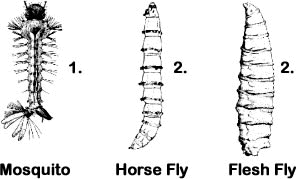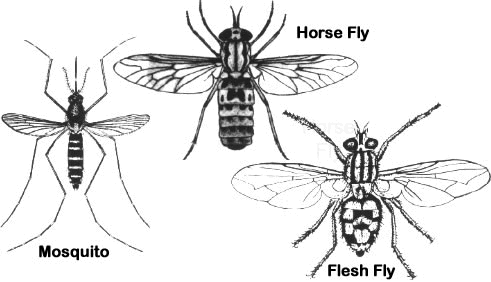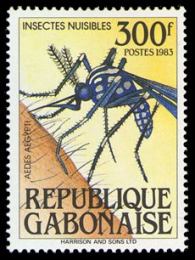Diptera
Pronunciation: [DIP·ter·a]
Pronunciation: [DIP·ter·a]
Common Name: True Flies / Mosquitoes / Gnats / Midges
Greek Origins of Name: Diptera, derived from the Greek words “di” meaning two and “ptera” meaning wings, refers to the fact that true flies have only a single pair of wings.
Asilidae — Robber Flies
Calliphoridae — Blow Flies
Chironomidae — Midges
Culicidae — Mosquitoes
Syrphidae — Flower Flies
Tabanidae — Horse Flies and Deer Flies
Tachinidae — Tachinid Flies
Tipulidae — Crane Flies
Holometabola i.e. complete metamorphosis (egg, larva, pupa, adult)
The Diptera have traditionally been divided into three suborders:
1. Nematocera (flies with multisegmented antennae)
2. Brachycera (flies with stylate antennae)
3. Cyclorrhapha (flies with aristate antennae)
In some newer classifications, Brachycera includes the Cyclorrhapha.
Abundant worldwide. Larvae are found in all fresh water, semi-aquatic, and moist terrestrial environments. Approximately 110 families and 17,000 species in North America and ~150 families and ~153,000 species worldwide.
The order Diptera includes all true flies. These insects are distinctive because their hind wings are reduced to small, club-shaped structures called halteres – only the membranous front wings serve as aerodynamic surfaces. The halteres vibrate during flight and work much like a gyroscope to help the insect maintain balance.
All Dipteran larvae are legless. They live in aquatic (fresh water), semi-aquatic, or moist terrestrial environments. They are commonly found in the soil, in plant or animal tissues, and in carrion or dung — almost always where there is little danger of desiccation. Some species are herbivores, but most feed on dead organic matter or parasitize other animals, especially vertebrates, molluscs, and other arthropods. In the more primitive families (suborder Nematocera), fly larvae have well-developed head capsules with mandibulate mouthparts. These structures are reduced or absent in the more advanced suborders (Brachycera and Cyclorrhapha) where the larvae, known as maggots, have worm-like bodies and only a pair of mouth hooks for feeding.
Adult flies live in a wide range of habitats and display enormous variation in appearance and life style. Although most species have haustellate mouthparts and collect food in liquid form, their mouthparts are so diverse that some entomologists suspect the feeding adaptations may have arisen from more than a single evolutionary origin. In many families, the proboscis (rostrum) is adapted for sponging and/or lapping. These flies survive on honeydew, nectar, or the exudates of various plants and animals (dead or alive). In other families, the proboscis is adapted for cutting or piercing the tissues of a host. Some of these flies are predators of other arthropods (e.g., robber flies), but most of them are external parasites (e.g., mosquitoes and deer flies) that feed on the blood of their vertebrate hosts, including humans and most wild and domestic animals.

1. Culiciform
–Head capsule present with chewing mouthparts
–Legs absent
2. Vermiform (maggots)
–Without legs or a distinct head capsule
–Mouthparts reduced; only present as mouth hooks

The Diptera probably have a greater economic impact on humans than any other group of insects. Some flies are pests of agricultural plants, others transmit diseases to humans and domestic animals. On the other hand, many flies are beneficial — particularly those that pollinate flowering plants, assist in the decomposition of organic matter, or serve as biocontrol agents of insect pests.
(Grouped by life history):
Biting flies: In most cases, only the adult females take blood meals.
Culicidae (mosquitoes) — may spread malaria, encephalitis, yellow fever, filariasis, and other diseases.
Tabanidae (horse flies / deer flies) — may spread tularemia, loiasis, trypanosomiasis, and other diseases.
Simuliidae (black flies) — may spread human onchoceriasis and leucocytozoon infections of poultry.
Psychodidae (moth flies) — may spread leishmaniasis, sand fly fever, and other diseases.
Ceratopogonidae (punkies, no-see-ums) — small but vicious biters that have been linked to the spread of several roundworm, protozoan, and viral pathogens in humans and other animals.
Muscidae (House flies) — these are among the most cosmopolitan of all insects. Some species have biting mouthparts, others are merely scavengers. Diseases such as dysentery, cholera, and yaws may be transmitted on their feet and mouthparts.
Herbivores: larvae feed on plant tissues.
Cecidomyiidae (gall midges) — some induce the formation of plant galls; others are scavengers, predators, or parasites. This family includes the Hessian fly, Mayetolia destructor.
Tephritidae (fruit flies) — many species are agricultural pests; such as the apple maggot, Rhagoletis pomonella.
Agromyzidae — most larvae are leaf miners, some are stem and seed borers. Several species are agricultural pests.
Anthomyiidae — many species are root or seed maggots.
Scavengers: larvae feed in dung, carrion, garbage, or other organic matter.
Drosophilidae (pomace flies) — feed on decaying fruit.
Tipulidae (crane flies) — larvae live in soil or mud.
Calliphoridae (blow flies) — larvae feed on garbage and carrion; includes the screwworm, Cochliomyia hominivorax.
Chironomidae (midges) — aquatic larvae usually live in the mud and feed on organic matter.
Sarcophagidae (flesh flies) — larvae typically feed on carrion. Some species may cause human myiasis.
Stratiomyidae (soldier flies) — larvae are most commonly found in animal excrement and decaying organic matter.
Predators: adults and/or larvae attack other insects as prey.:
Asilidae (robber flies) — general predators of other insects.
Bombyliidae (bee flies) — predatory larvae; adult bee mimics.
Empididae (dance flies) — adults are predatory.
Syrphidae (flower flies) — some larvae are aphid predators; most adults mimic bees or wasps.
Parasites: larvae are parasites or parasitoids of other animals.
Tachinidae — parasitoids of other insects. Several species are important biocontrol agents.
Sciomyzidae (marsh flies) — larvae parasitize slugs and snails.
Oestridae (bot flies / warble flies) — larvae are endoparasites of mammals, including humans.
Hippoboscidae (louse flies) — adults are blood-feeding ectoparasites of birds and mammals.
 The yellowfever mosquito (Aedes aegypti) is a threat to human health throughout much of the tropics. In addition to yellow fever, it is also an important vector of dengue and chikungunya viruses. This stamp was issued by the African republic of Gabon in 1983.
The yellowfever mosquito (Aedes aegypti) is a threat to human health throughout much of the tropics. In addition to yellow fever, it is also an important vector of dengue and chikungunya viruses. This stamp was issued by the African republic of Gabon in 1983.